Which Of The Following Is Not True About The Service Phase Of Technology
Courses & Certification
- Instructional Design Certificate (Fully Online). This fully online programme is for anyone developing and/or education an online grade. Larn more...
- ADDIE Instructional Design Certificate Program (Fully Online). This fully online plan is designed for individuals interested in learning more about the ADDIE model. Acquire more...
- Instructional Design Models Certificate (Fully Online). You will explore traditional instructional blueprint models and the progression of the learning design arroyo to creating online learning experiences. Larn more than...
For many years at present, educators and instructional designers akin have used the ADDIE Instructional Design (ID) method equally a framework in designing and developing educational and training programs. "ADDIE" stands for Analyze, Design, Develop, Implement, and Evaluate. This sequence, however, does not impose a strict linear progression through the steps. Educators, instructional designers and preparation developers find this approach very useful because having stages clearly divers facilitates implementation of effective preparation tools. As an ID model, Addie Model has institute wide acceptance and utilize.
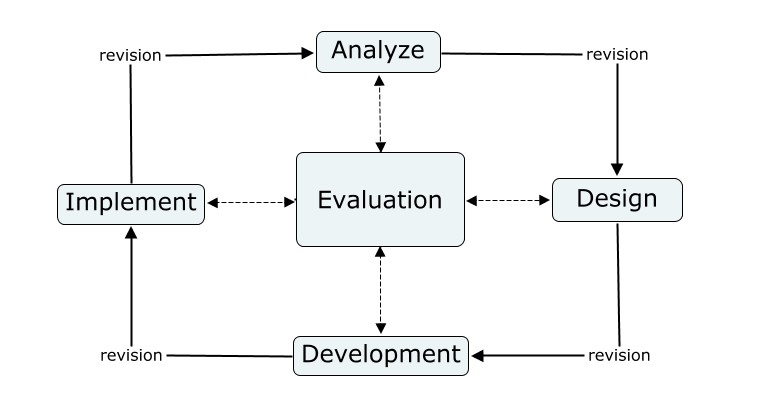
Most ID models are variations of the ADDIE model.
The concept of Instructional Design can be traced back to as early on as the 1950s. But it wasn't until 1975 that ADDIE was designed. Originally developed for the U.S. Ground forces by the Centre for Educational Technology at Florida Country University, ADDIE was later implemented beyond all branches of the U.S. Armed Forces.
The ADDIE model was based on an before ID model, the Five Footstep Arroyo, which had been developed by the U.South. Air Force. The ADDIE model retained this five-step feature, and included many sub-stages within each of the v wide phases. Due to the hierarchical structure of the steps, 1 had to complete the process in a linear way, completing one phase before starting the adjacent.
Practitioners over the years accept made several revisions in the stages of the original hierarchical version. This has made the model more interactive and dynamic. Information technology was in the mid-1980s that the version similar to the current version appeared. Today, the influence of the ADDIE method can exist seen on nigh ID models being used.
Addie: Stages
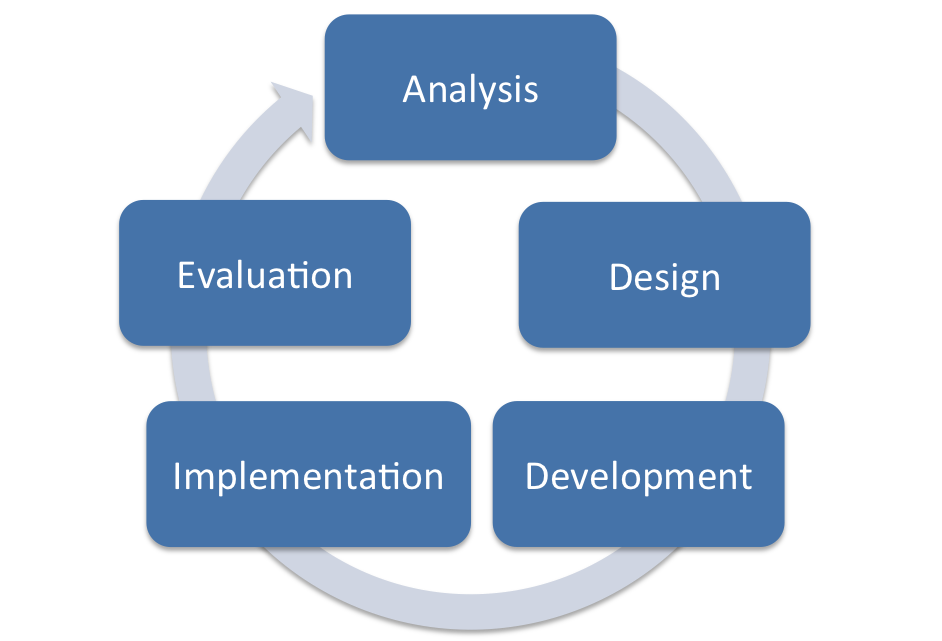
The v components of the Addie Model are:
Analysis
The Assay phase tin can be considered as the "Goal-Setting Stage." The focus of the designer in this phase is on the target audience. It is likewise hither that the program matches the level of skill and intelligence that each educatee/participant shows. This is to ensure that what they already know won't exist duplicated, and that the focus will instead be on topics and lessons that students have however to explore and learn. In this phase, instructors distinguish between what the students already know and what they should know after completing the course.
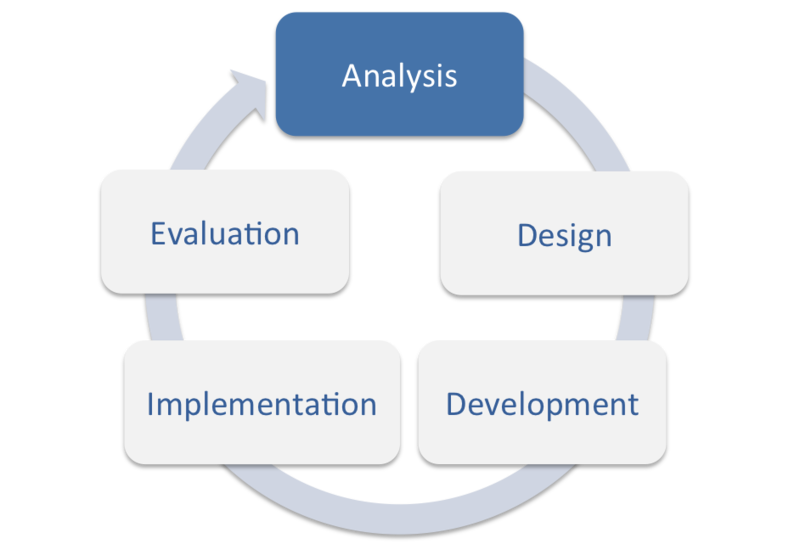
Several fundamental components are to be utilized to brand certain analysis is thorough. Course texts and documents, syllabi and the net are to be employed. With the help of online materials such as spider web courses, a structure can exist determined equally the master guide for the syllabus. At the terminate of the program, instructional assay will be conducted to determine what subjects or topics are to be included. The Analysis Phase generally addresses the following issues and questions:
- What is the typical background of the students/participants who volition undergo the program? Personal and educational information such as age, nationality, previous experiences and interests should be adamant. What is the target group? What are the educational goals, past knowledge levels, experiences, ages, interests, cultural groundwork etc. of the learners?
- What do the students need to accomplish at the end of the plan? What are the learner'due south needs?
- What will be required in terms of skills, intelligence, outlook and physical/psychological action-reaction? What are the desired learning outcomes in terms of knowledge, skills, attitudes, behavior etc.?
- Determining popular methods being used around the subject and taking a look at what needs to be developed and improved. Review of existing instructional strategies employed. Are they adequate? What aspects need to be added, clarified and improved upon?
- Determining target objectives of the projection. What instructional goals does the project focus on?
- Determining the diverse options available with respect to learning environs. What is the virtually conducive learning environment? A combination of alive or online discussions? What are the Pros and Cons betwixt online- and classroom-based study? What commitment option is to be chosen? What type of learning environment is preferred? Does 1 opt for online or contiguous or a blend of both? If online is preferred what will be the difference in learning outcomes betwixt classroom-based learning and web-based learning?
- Determining limiting factors to the overall goal of the project. What limiting factors exist with respect to resources, including technical, support, time, human resources, technical skills, fiscal factors, back up factors?
Design
This phase determines all goals, tools to be used to judge functioning, various tests, subject matter analysis, planning and resource. In the pattern phase, the focus is on learning objectives, content, subject matter analysis, exercise, lesson planning, assessment instruments used and media choice.

The approach in this stage should be systematic with a logical, orderly process of identification, development and evaluation of planned strategies which target the attainment of the project's goals. It should follow a very specific set of rules, and each chemical element of the instructional pattern plan must be executed with attention to detail. Being a stickler for the details is crucial to the success of the design stage. This systematic approach makes sure that everything falls within a rational and planned strategy, or set of strategies, that has the ultimate goal of reaching the project's targets. During the design stage, the IDs demand to determine:
- Dissimilar types of media to be used. Sound, Video and Graphics are prime examples. Are third party resources going to be utilized or will the IDs create their own? Volition you prepare the teaching learning material?
- Various resource at manus required to complete the projection. What are the available resources at your disposal for completing the project?
- Level and types of activity to be generated during the study. Is it going to exist collaborative, interactive or on a per participant basis?
- Using a teacher's style arroyo, how will yous implement the parts of the project (i.e. behaviorist, constructivist, etc.)?
- Time frame for each activeness. How much time is to be assigned to each task, and how will learning exist implemented (per lesson, chapter, module, etc.)? Do the topics crave a linear progression in presentation (i.e. like shooting fish in a barrel to difficult)?
- The unlike mental processes needed by the participants in order to meet the targets of the project. What are the prescribed cognitive skills for students to achieve the project's learning goals?
- Cognition and skill developed after each job. Do you take a manner of determining that such values have indeed been accomplished by the students? What is the method adopted past yous to determine the acquisition of desired competencies by the students?
- The roadmap of how the study or project will appear on paper. Will information technology exist advantageous to the ID to create a map of the different activities to encounter if they are in line with the goal of the projection?
- If the project is web-based, what kind of user interface volition yous employ? Do you already have an idea on how the site volition look like?
- The feedback machinery y'all will use to determine if the participants are able to digest the lessons. What is the machinery designed by you to obtain the learners' feedback on material learnt?
- Given the wide diverseness of pupil preferences and learning styles, what method volition you lot implement to brand sure that the program fits their wants? How will you design your project activities then as to appeal to various learning styles and interests of students? Volition you opt for multifariousness in delivery options and media type?
- Pinpoint the primary idea of the project (training activity).
Development
The Development phase starts the production and testing of the methodology being used in the project. In this phase, designers make use of the data nerveless from the two previous stages, and apply this information to create a programme that will relay what needs to be taught to participants. If the two previous stages required planning and brainstorming, the Evolution phase is all virtually putting it into action. This stage includes three tasks, namely drafting, production and evaluation.
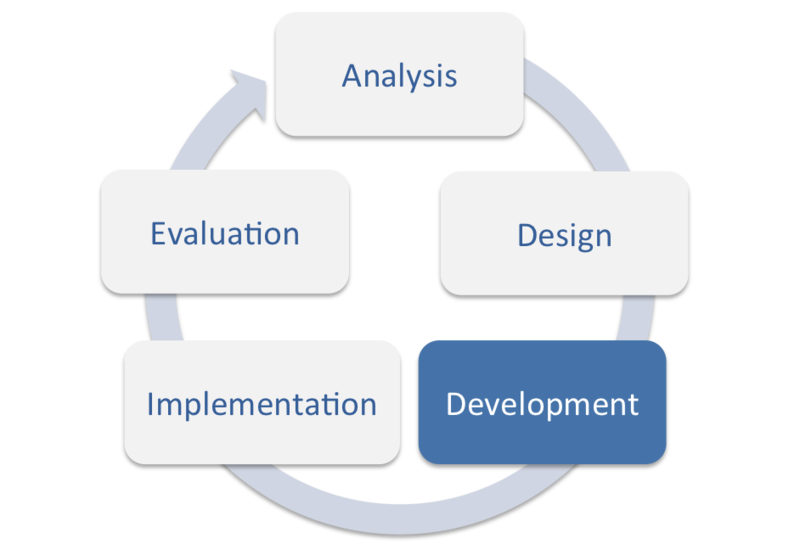
Evolution thus involves creating and testing of learning outcomes. It aims to address the post-obit questions:
- Is the fourth dimension frame being adhered to in relation to what has been achieved in terms of material? Are you creating materials as per schedule?
- Practice y'all encounter squad piece of work across various participants? Are the members working effectively as a team?
- Are participants contributing as per their optimal capacity?
- Are the materials produced up to task on what they were intended for?
Implementation
The implementation stage reflects the continuous modification of the program to make certain maximum efficiency and positive results are obtained. Hither is where IDs strive to redesign, update, and edit the course in lodge to ensure that it tin can exist delivered finer. "Procedure" is the key word here. Much of the real work is done here as IDs and students piece of work hand in manus to railroad train on new tools, so that the blueprint tin can be continuously evaluated for further improvement. No projection should run its course in isolation, and in the absenteeism of proper evaluation from the IDs. Since this stage gains much feedback both from IDs and participants akin, much tin can exist learned and addressed.
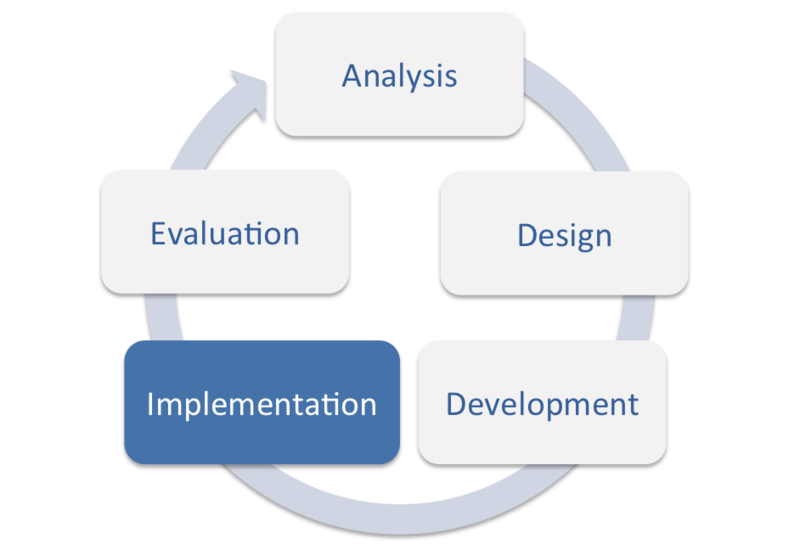
Design evaluation is washed in the implementation stage. Designers play a very active office in this phase, which is crucial for the success of the project. Developers should consistently analyze, redesign and enhance the production to ensure effective product delivery. Meticulous monitoring is a must. Proper evaluation of the production, course or program, with necessary and timely revisions, is done in this phase. When instructors and learners actively contribute during the implementation procedure, instantaneous modifications tin be made to the project, thus making the program more effective and successful.
The following are examples of what tin be determined:
- Advise on your preferred method of record keeping, as well every bit the actual data you would like to mine from the experience of students interfacing with the project.
- What is the emotional feedback given to yous by teachers and students during initial demonstration of the project? Are they genuinely interested, eager, critical or resistant?
- Equally the project proceeds, do you encounter that IDs are able to grasp the topic immediately or practise they demand help?
- Explain how you are going to deal with any possible errors during testing. What will your response be if, after presenting activities to students, things practice not become as planned?
- Did you fix a back-upwardly tool in the outcome of initial failure of the projection? When technical and other problems ascend practice you have a dorsum-up strategy?
- Volition you lot go for implementation on a small scale or a big scale?
- When the student grouping gets the fabric tin can they work independently, or is constant guidance required?
Evaluation
The last stage of the ADDIE method is Evaluation. This is the stage in which the project is being subjected to meticulous final testing regarding the what, how, why, when of the things that were achieved (or non accomplished) of the unabridged project. This phase tin can exist cleaved down into 2 parts: Formative and Summative. The initial evaluation actually happens during the evolution stage. The Formative phase happens while students and IDs are conducting the written report, while the Summative portion occurs at the end of the program. The main goal of the evaluation phase is to determine if the goals have been met, and to plant what will be required moving forward in lodge to further the efficiency and success rate of the project.
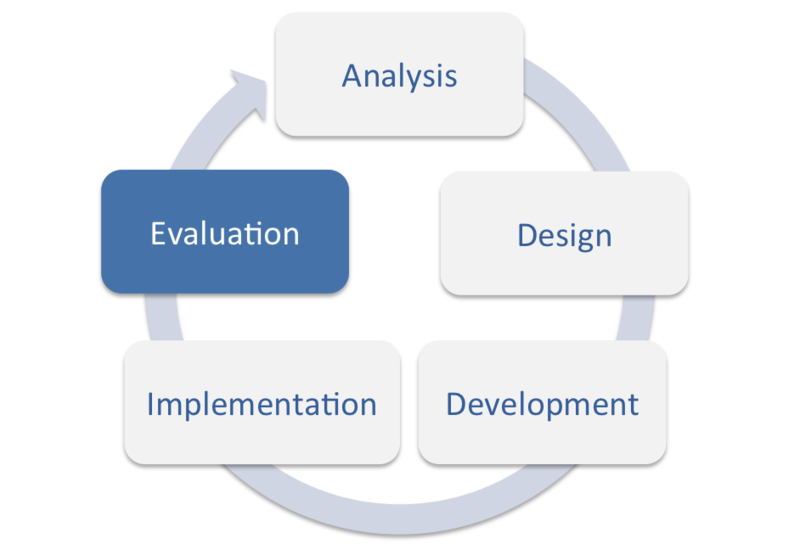
Every stage of the ADDIE process involves determinative evaluation. This is a multidimensional—and essential—component of the ADDIE procedure. Evaluation is washed throughout the implementation phase with the assist of the teacher and the students. Afterwards implementation of a course or program is over, a summative evaluation is done for instructional improvement. Throughout the evaluation phase the designer should ascertain whether problems relevant to the training program are solved, and whether the desired objectives are met.
While often overlooked due to time constraints and monetary reasons, Evaluation is an essential step of the whole ADDIE method as it aims to respond the post-obit questions:
- Determine the categories that will be established to evaluate the effectiveness of the projection (i.e. improved learning, increased motivation etc.) On what factors or criteria will the effectiveness of project be determined?
- Decide the way you will implement data collection, as well as the timing at which it will be finer made. When will the data related to the project'due south overall effectiveness be collected and how?
- Determine a arrangement for analyzing participant feedback.
- Determine the method to exist used if some parts of the project demand to be changed prior to full release. On what basis will you go far at a decision to revise sure aspects of the project before its total implementation?
- Decide the method by which reliability and content validity tin be observed.
- Decide the method by which y'all will know if instructions are articulate. How is the clarity of instructions assessed?
- Make up one's mind the method past which you lot can analyze and class the response of the participants on the project.
- Decide who gets to receive your final output regarding the projection. Who will prepare this report on the results of the evaluation?
Source: https://educationaltechnology.net/the-addie-model-instructional-design/
Posted by: matthiesaltrove88.blogspot.com


0 Response to "Which Of The Following Is Not True About The Service Phase Of Technology"
Post a Comment